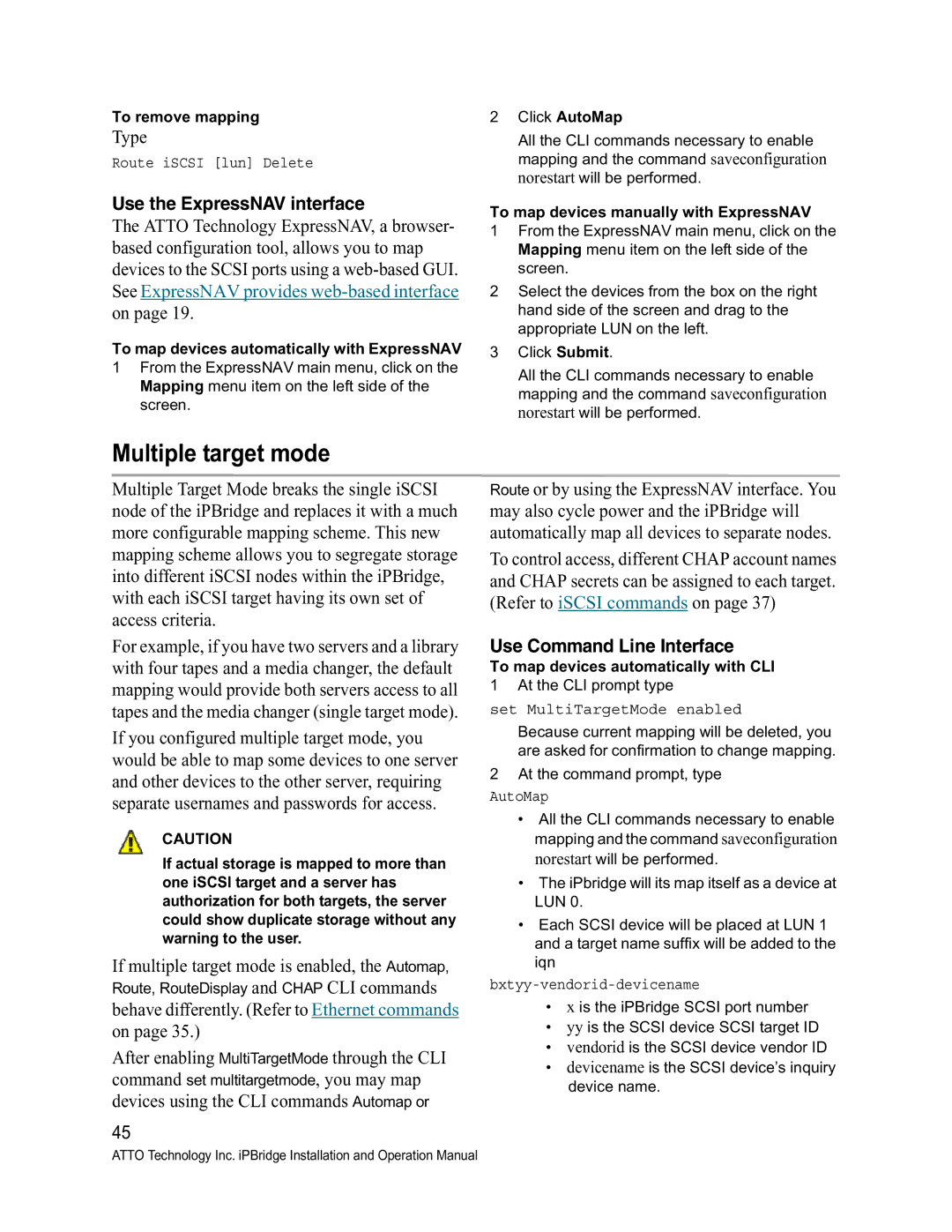
To remove mapping
Type
Route iSCSI [lun] Delete
Use the ExpressNAV interface
The ATTO Technology ExpressNAV, a browser- based configuration tool, allows you to map devices to the SCSI ports using a
To map devices automatically with ExpressNAV
1From the ExpressNAV main menu, click on the Mapping menu item on the left side of the screen.
2Click AutoMap
All the CLI commands necessary to enable mapping and the command saveconfiguration norestart will be performed.
To map devices manually with ExpressNAV
1From the ExpressNAV main menu, click on the Mapping menu item on the left side of the screen.
2Select the devices from the box on the right hand side of the screen and drag to the appropriate LUN on the left.
3Click Submit.
All the CLI commands necessary to enable mapping and the command saveconfiguration norestart will be performed.
Multiple target mode
Multiple Target Mode breaks the single iSCSI node of the iPBridge and replaces it with a much more configurable mapping scheme. This new mapping scheme allows you to segregate storage into different iSCSI nodes within the iPBridge, with each iSCSI target having its own set of access criteria.
For example, if you have two servers and a library with four tapes and a media changer, the default mapping would provide both servers access to all tapes and the media changer (single target mode).
If you configured multiple target mode, you would be able to map some devices to one server and other devices to the other server, requiring separate usernames and passwords for access.
CAUTION
If actual storage is mapped to more than one iSCSI target and a server has authorization for both targets, the server could show duplicate storage without any warning to the user.
If multiple target mode is enabled, the Automap,
Route, RouteDisplay and CHAP CLI commands
behave differently. (Refer to Ethernet commands on page 35.)
After enabling MultiTargetMode through the CLI
command set multitargetmode, you may map
devices using the CLI commands Automap or
45
Route or by using the ExpressNAV interface. You may also cycle power and the iPBridge will automatically map all devices to separate nodes.
To control access, different CHAP account names and CHAP secrets can be assigned to each target. (Refer to iSCSI commands on page 37)
Use Command Line Interface
To map devices automatically with CLI
1 At the CLI prompt type
set MultiTargetMode enabled
Because current mapping will be deleted, you are asked for confirmation to change mapping.
2 At the command prompt, type
AutoMap
•All the CLI commands necessary to enable mapping and the command saveconfiguration norestart will be performed.
•The iPbridge will its map itself as a device at LUN 0.
•Each SCSI device will be placed at LUN 1 and a target name suffix will be added to the iqn
bxtyy-vendorid-devicename
•x is the iPBridge SCSI port number
•yy is the SCSI device SCSI target ID
•vendorid is the SCSI device vendor ID
•devicename is the SCSI device’s inquiry device name.
ATTO Technology Inc. iPBridge Installation and Operation Manual
